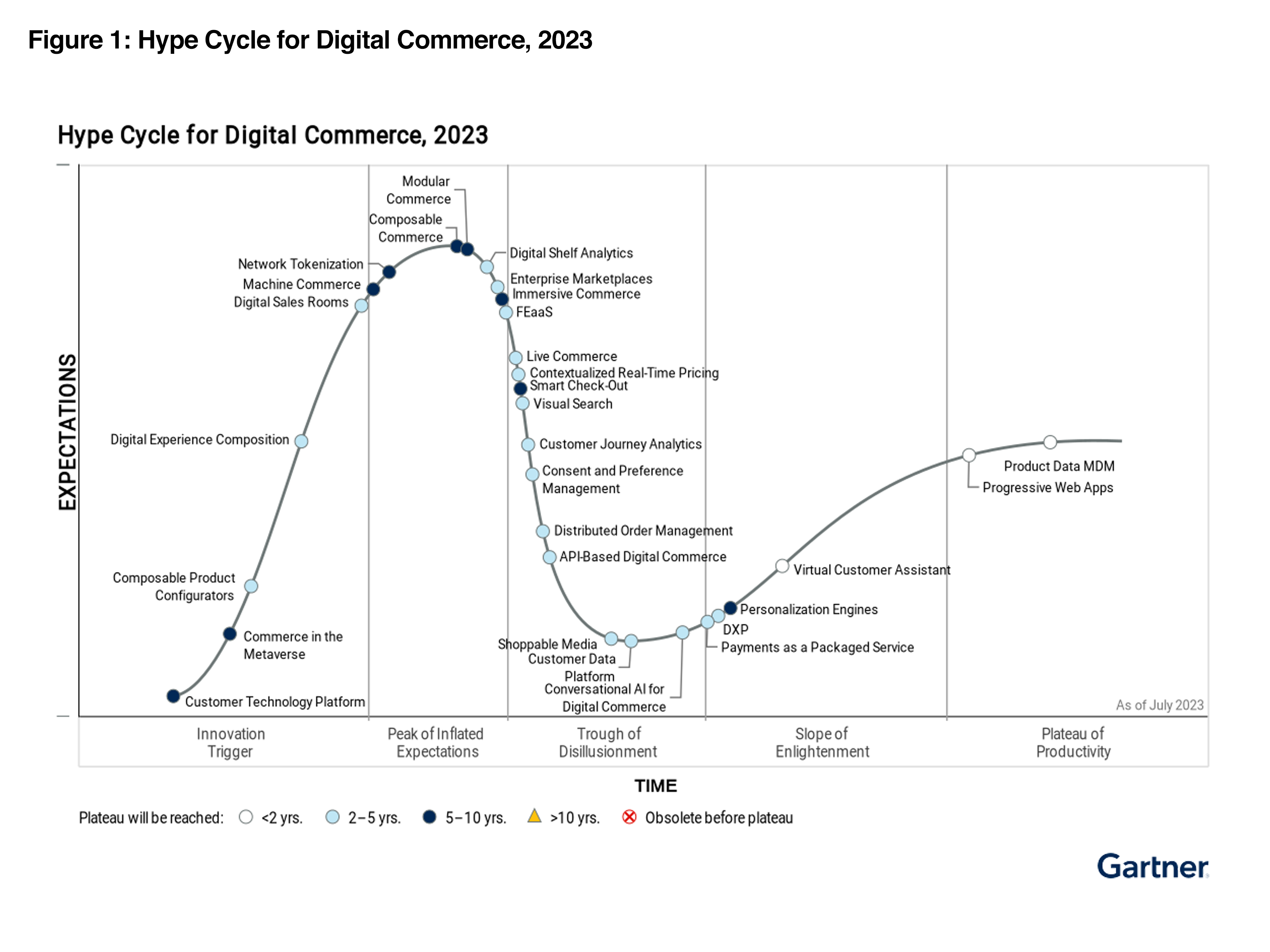
The Gartner Hype Cycle for Digital Commerce 2023 presents a wide range of new commerce technologies designed to support organizations that have a digital commerce growth strategy in place. According to the Gartner website, it is designed to provide, “a graphic representation of the maturity and adoption of technologies and applications, and how they are potentially relevant to solving real business problems and exploiting new opportunities.”
This year’s report shares insights on composable commerce, giving the architectural approach to digital commerce whereby applications are constructed with packaged business capabilities (PBCs) a benefit ranking of “transformational.” The report also recognized commercetools as a Sample Vendor in Composable Commerce, Modular Commerce and API-based Digital Commerce technologies.

“Composability is a strong theme this year, not only for the core digital commerce platforms but also ecosystem applications, such as DXP and product configurators,” summarizes the newest Hype Cycle report. It explains that “as organizations face economic pressures, digital commerce remains an important component of their digital strategy that supports growth while keeping costs down.”
Since its inception, commercetools has been adamant in its belief that by taking a composable approach to building their commerce stack — using commercetools Composable Commerce as the foundation — organizations can gain the flexibility and agility to accomplish this goal.
Both modular commerce and composable commerce will substantiate in five to 10 years. Organizations with advanced technical skills can compose their unique experience, and vendors are making their solutions more business-user friendly by embedding third-party applications. Other organizations can also benefit from a modular solution that is more frequently updated by the vendor and enables faster speed to market and cost-effectiveness when using fewer modules.
While the report shares insights on Composable Commerce, Modular Commerce and API -based Digital Commerce, Kelly Goetsch, Chief Strategy Officer at commercetools, feels the key takeaway for business leaders is to recognize that, “If they’re still running on a monolithic platform that, they’re going to have difficulty remaining competitive.”
There are differences but the differences really don’t matter. What matters is having a system in place that allows you to swap things out, so you can iterate and innovate. You need to be able to implement one piece at a time. To do that you need a system where the modules are encapsulated as APIs and can be consumed independently — this is key to incremental adoption over time — and if you don’t have a system that supports this, eventually, you’re going to be in big trouble.
CHIEF STRATEGY OFFICER, COMMERCETOOLS
As Gartner presented in the report, in today’s environment, “Digital commerce solutions must be flexible and nimble to respond quickly to changing customer expectations. Companies must respond quickly with new products, processes, delivery methods and customer experiences.”
Composable commerce enables solution changes to be made, deployment to production environments, and achieve scaling more flexibly, whereas a monolithic platform includes many tightly coupled components that are not changed in every release.
Gartner gave composable commerce a transformational benefit ranking, which is defined as a technology that enables new ways organizations do business resulting in major shifts in industry dynamics. Out of a total of 30 technologies highlighted on this year’s Hype Cycle, many others given a transformational benefit ranking include Modular Commerce and API-based Digital Commerce (discussed above), as well as customer technology platforms, digital sales rooms, smart checkout and conversational AI for digital commerce.
Digital sales rooms allow B2B organizations to improve sales productivity when using the digital channel, while leveraging existing sales and service teams. Conversational AI for digital commerce has limitations in understanding user context, but these issues can potentially be addressed by fine tuning LLMs, such as ChatGPT, driving conversational AI for digital commerce toward the plateau.
Gartner mentioned several technologies that significantly advanced in 2023, including Frontend as a Service (FEaaS) which was assigned a benefit ranking of high. According to Gartner, the business impact of embracing FEaaS is that “Client-side front ends significantly improve performance for web apps, especially on low bandwidths. They improve customer experience regardless of display or viewport size, providing more “app-like” experiences, especially via mobile devices.”

commercetools Frontend offers a robust solution that provides customers with the ability to rapidly deploy rich marketing and merchandising experiences for their shoppers, all within a headless architecture. Brands across multiple industries around the globe including flaconi, Lakrids by Bülow, Loomstate and CHRONEXT are all using commercetools Frontend to differentiate themselves from the competition.
We probably wouldn’t have gone headless if we hadn’t found commercetools Frontend. They’re the solution that makes the headless approach work for our brand managers.
HEAD OF TECHNOLOGY, APG & CO.
Payment as a Packaged Service, digital experience composition (DXC), contextualized real-time pricing and customer journey analytics were also included on the Hype Cycle and reviewed in the report. commercetools believes all of these technologies are ones that commerce leaders should consider exploring.
I think Gartner offers a very detailed taxonomy of commerce technology. However, at the end of the day, it all comes down to the fact that anything is possible in a composable environment. Whatever it is you want to do — add visual search, enable network tokenization, integrate digital shelf analytics, etc. — it’s going to be easier if you have a composable foundation.
CHIEF STRATEGY OFFICER, COMMERCETOOLS
To learn more about why composable commerce was given a benefit ranking of transformational and explore all 30 technologies featured in the Hype Cycle, download your complimentary copy of the Gartner Hype Cycle for Digital Commerce 2023 today.